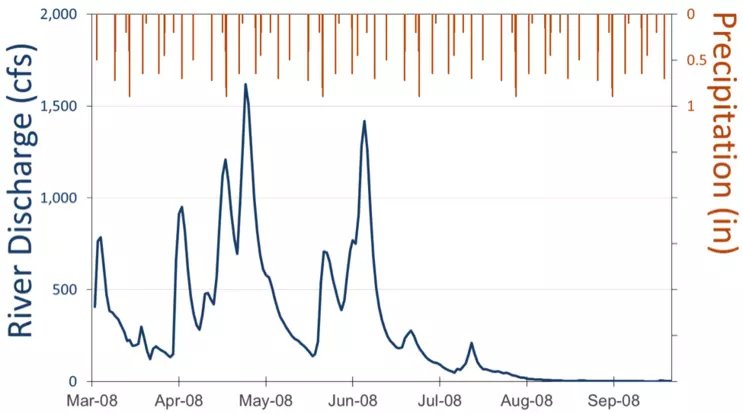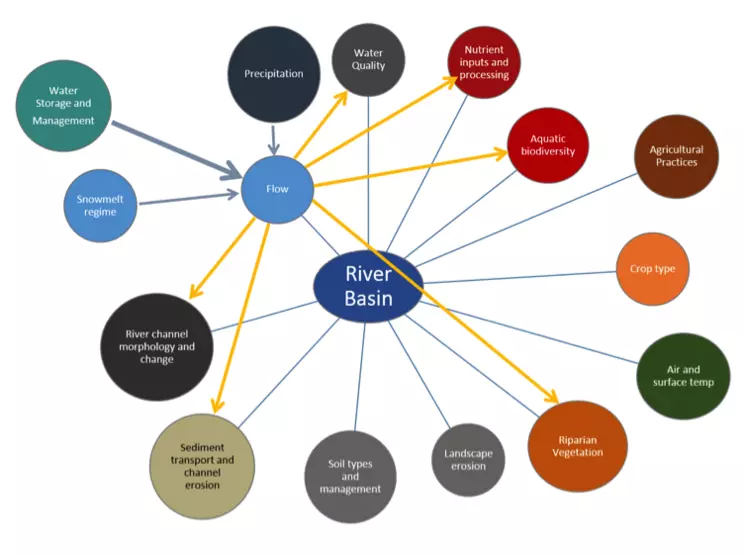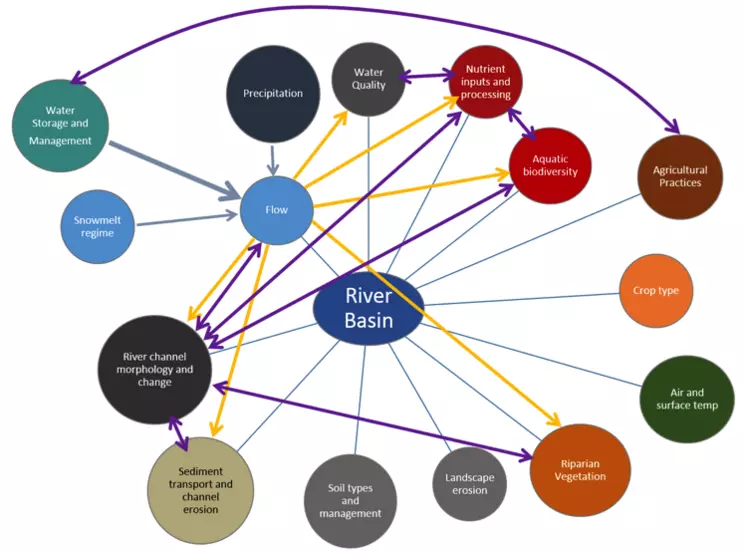For the Instructor
These student materials complement the Water Science and Society Instructor Materials. If you would like your students to have access to the student materials, we suggest you either point them at the Student Version which omits the framing pages with information designed for faculty (and this box). Or you can download these pages in several formats that you can include in your course website or local Learning Managment System. Learn more about using, modifying, and sharing InTeGrate teaching materials.Watersheds are complex systems
When you look around, you see that the world is full of systems...assemblages or combinations of things that form a functional unit. Some systems are human-made, others are made by nature. Some systems are simple, meaning the way they work is straightforward and the outputs from the system are easily predictable. Other systems are complex, meaning they often have many parts that interact, often in non-linear ways, making the outputs from those systems more difficult to predict.
For example, a coffee maker is a pretty simple system. You put in 8 cups of water and two cups of coffee grounds and (assuming you put them in the right places), you turn the machine on and get ~8 cups of coffee. If you change the amounts of either of the inputs, it is pretty easy to predict the impacts on the coffee you brew.
Watersheds are not such simple system. They are incredibly complex. One example can be seen in how the relationship between rainfall and runoff changes throughout the year. In a simple system, you would expect a constant relationship between incoming rainfall and outgoing flow. For example, a 1 inch rain event should translate to a stormflow hydrograph that might last 2 days and peak at 1000 cfs. But this isn't what we see. Figure 3 shows streamflow (blue line, values on the left axis) and precipitation (orange bars, values on the right axis) from March through September, 2008 for the Maple River near Rapidan, Minnesota. Precipitation is relatively evenly distributed throughout the year. As you can see, in April and May, rainfall events that are 0.5 to 1 inch result in relatively high flows (1000 to 1500 cfs). However, in July, August and September, similar rainfall events hardly elicit any flow response whatsoever! Why do we see such non-linear behavior?

Source: Data from the Minnesota Pollution Control Agency. Plot created by Patrick Belmont.
Activate Your Learning
The Maple River example above is a relatively extreme example of changes in rainfall-runoff relationships because soils are relatively wet (and therefore can't absorb much of the incoming rainfall) in the spring and there is very little vegetation to intercept or evapotranspire water (the watershed is covered in row crops that don't grow much before mid-June). In contrast, the row crops are in full effect by mid-summer and early fall and therefore they dry out the soil, intercept some incoming rainfall and evapotranspire most of the rest of the incoming rainfall...so it never gets to the channel! But similar phenomena can be seen in other watersheds. Find precipitation and streamflow data for a watershed of interest to you (from the USGS website, NRCS SNOTEL website, or NWS website). Plot them as shown in Figure 3. How well does flow correlate with precipitation? Are there seasonal differences? Differences from year to year?
Watersheds comprise many interacting parts. Figure 4 (top panel) is one way to represent various 'parts' that might be considered to comprise the watershed. While this is clearly a very simple view of this complex system, it is useful to take a "crude look at the whole", a term coined by Nobel Prize winning Physicist Murray Gell-Mann, as starting point. When one component of the system is systematically changed, it may have direct as well as indirect impacts that propagate through the system. For example, changes in precipitation, snowmelt regime, or water storage may change streamflow. This altered streamflow has direct effects on river channel morphology, sediment transport, riparian vegetation, water quality, nutrient processing, and biodiversity, as indicated by the yellow arrows in the middle panel of Figure 4. But there are other interactions within the system, feedbacks that are indicated by purple arrows in the bottom panel of Figure 4. So to predict impacts of the changes in flow on aquatic biodiversity you would have to take into account not only the direct effects (yellow arrow between flow and aquatic biodiversity, but also the indirect effects associated with changes in channel morphology. This concept is also relevant in the context of watershed 'restoration'. If a particular stretch of stream is impaired for one function or another (e.g., fish habitat has been degraded), in some cases it makes sense to 'fix' that specific stretch of river, while in other cases the impairment is simply a symptom of problems higher up in the watershed, so the 'fix' may need to be applied at that distant location in the watershed before human intervention or natural processes can begin to repair the impaired stretch of stream.
These notions of complex feedbacks and cascading effects greatly complicate the process of predicting what impacts human activities or natural disturbances within a watershed might have downstream. We'll come back to this theme of system dynamics and complexity throughout the course.



Source: Patrick Belmont





